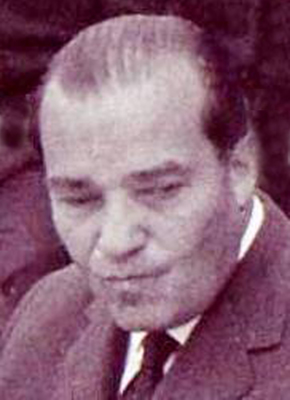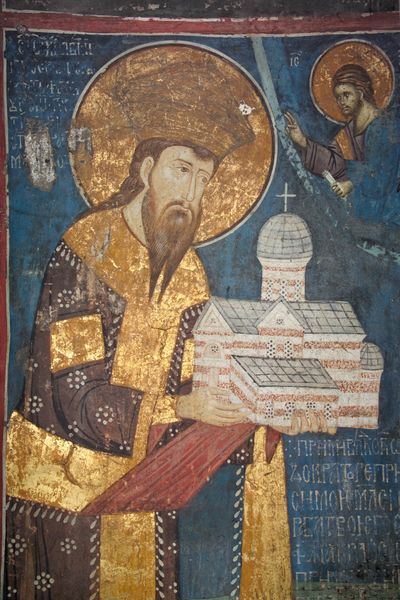|
Filaret Scriban
Filaret Scriban (; born Vasile Scriban ; 1811–March 23, 1873) was a Moldavian and Romanian theologian within the Romanian Orthodox Church. Born in Burdujeni, Botoșani County, then a village near Suceava, his father was a priest. Leaving for Iași, the capital of Moldavia, he studied at the Vasilian College and at ''Academia Mihăileană'' between 1830 and 1837. Meanwhile, between 1834 and 1837, he taught at the normal school associated with Trei Ierarhi Monastery and was a part-time teacher at ''Academia Mihăileană'' from 1837 to 1839. He was sent to study at Kiev Theological Academy, where he remained from 1839 to 1842 and obtained a master's degree in theology. He entered Kiev Pechersk Lavra, taking the name Filaret, and was ordained a hieromonk in 1842. From that time until 1860, he taught at the Socola Monastery, eventually becoming rector, as well as abbot of the monastery. He attained the rank of archimandrite in 1843, and was styled titular bishop of Stavropoleos ... [...More Info...] [...Related Items...] OR: [Wikipedia] [Google] [Baidu] |
Filaret Scriban
Filaret Scriban (; born Vasile Scriban ; 1811–March 23, 1873) was a Moldavian and Romanian theologian within the Romanian Orthodox Church. Born in Burdujeni, Botoșani County, then a village near Suceava, his father was a priest. Leaving for Iași, the capital of Moldavia, he studied at the Vasilian College and at ''Academia Mihăileană'' between 1830 and 1837. Meanwhile, between 1834 and 1837, he taught at the normal school associated with Trei Ierarhi Monastery and was a part-time teacher at ''Academia Mihăileană'' from 1837 to 1839. He was sent to study at Kiev Theological Academy, where he remained from 1839 to 1842 and obtained a master's degree in theology. He entered Kiev Pechersk Lavra, taking the name Filaret, and was ordained a hieromonk in 1842. From that time until 1860, he taught at the Socola Monastery, eventually becoming rector, as well as abbot of the monastery. He attained the rank of archimandrite in 1843, and was styled titular bishop of Stavropoleos ... [...More Info...] [...Related Items...] OR: [Wikipedia] [Google] [Baidu] |
United Principalities
The United Principalities of Moldavia and Wallachia ( ro, Principatele Unite ale Moldovei și Țării Românești), commonly called United Principalities, was the personal union of the Principality of Moldavia and the Principality of Wallachia, formed on when Alexandru Ioan Cuza was elected as the ''Domnitor'' (Ruling Prince) of both principalities, which were autonomous but still vassals of the Ottoman Empire and which resulted in the unification of both principalities. On , Moldavia and Wallachia formally united to create the Romanian United Principalities, the core of the Romanian nation state. In February 1866, Prince Cuza was forced to abdicate and go into exile by a political coalition led by the Liberals; the German Prince Karl of Hohenzollern-Sigmaringen was offered the Throne and, on he entered Bucharest for the first time. In July the same year, a new constitution came into effect, giving the country the name of Romania; internationally, this name was used only afte ... [...More Info...] [...Related Items...] OR: [Wikipedia] [Google] [Baidu] |
Romanian Theologians
Romanian may refer to: *anything of, from, or related to the country and nation of Romania **Romanians, an ethnic group **Romanian language, a Romance language ***Romanian dialects, variants of the Romanian language **Romanian cuisine, traditional foods **Romanian folklore *Romanian (stage), a stage in the Paratethys The Paratethys sea, Paratethys ocean, Paratethys realm or just Paratethys was a large shallow inland sea that stretched from the region north of the Alps over Central Europe to the Aral Sea in Central Asia. Paratethys was peculiar due to its pa ... stratigraphy of Central and Eastern Europe *'' The Romanian'' newspaper *'' The Romanian: Story of an Obsession'', a 2004 novel by Bruce Benderson * * {{disambiguation Language and nationality disambiguation pages ... [...More Info...] [...Related Items...] OR: [Wikipedia] [Google] [Baidu] |
People From Suceava
A person ( : people) is a being that has certain capacities or attributes such as reason, morality, consciousness or self-consciousness, and being a part of a culturally established form of social relations such as kinship, ownership of property, or legal responsibility. The defining features of personhood and, consequently, what makes a person count as a person, differ widely among cultures and contexts. In addition to the question of personhood, of what makes a being count as a person to begin with, there are further questions about personal identity and self: both about what makes any particular person that particular person instead of another, and about what makes a person at one time the same person as they were or will be at another time despite any intervening changes. The plural form "people" is often used to refer to an entire nation or ethnic group (as in "a people"), and this was the original meaning of the word; it subsequently acquired its use as a plural form of ... [...More Info...] [...Related Items...] OR: [Wikipedia] [Google] [Baidu] |
1873 Deaths
Events January–March * January 1 ** Japan adopts the Gregorian calendar. ** The California Penal Code goes into effect. * January 17 – American Indian Wars: Modoc War: First Battle of the Stronghold – Modoc Indians defeat the United States Army. * February 11 – The Spanish Cortes deposes King Amadeus I, and proclaims the First Spanish Republic. * February 12 ** Emilio Castelar, the former foreign minister, becomes prime minister of the new Spanish Republic. ** The Coinage Act of 1873 in the United States is signed into law by President Ulysses S. Grant; coming into effect on April 1, it ends bimetallism in the U.S., and places the country on the gold standard. * February 20 ** The University of California opens its first medical school in San Francisco. ** British naval officer John Moresby discovers the site of Port Moresby, and claims the land for Britain. * March 3 – Censorship: The United States Congress enacts the Comstock Law, making it ... [...More Info...] [...Related Items...] OR: [Wikipedia] [Google] [Baidu] |
1811 Births
Events January–March * January 8 – An unsuccessful slave revolt is led by Charles Deslondes, in St. Charles and St. James Parishes, Louisiana. * January 17 – Mexican War of Independence – Battle of Calderón Bridge: A heavily outnumbered Spanish force of 6,000 troops defeats nearly 100,000 Mexican revolutionaries. * January 22 – The Casas Revolt begins in San Antonio, Spanish Texas. * February 5 – British Regency: George, Prince of Wales becomes prince regent, because of the perceived insanity of his father, King George III of the United Kingdom. * February 19 – Peninsular War – Battle of the Gebora: An outnumbered French force under Édouard Mortier routs and nearly destroys the Spanish, near Badajoz, Spain. * March 1 – Citadel Massacre in Cairo: Egyptian ruler Muhammad Ali kills the last Mamluk leaders. * March 5 – Peninsular War – Battle of Barrosa: A French attack fails, on a larger Anglo-Portuguese-Sp ... [...More Info...] [...Related Items...] OR: [Wikipedia] [Google] [Baidu] |
Mircea Păcurariu
Mircea Păcurariu (30 July 1932 – 13 January 2021) was a Romanian theologian, historian and priest in the Romanian Orthodox Church. Biography Born in Ruși, Hunedoara County, he was the son of the village priest. He enrolled in the History faculty of Babeș University in Cluj, but had to leave after his first year because the Communist Romanian authorities viewed his social origin as unacceptable. He later attended the theological seminaries in Sibiu and in Bucharest, then taught at the seminaries of Neamț Monastery The Neamț Monastery ( ro, Mănăstirea Neamț) is a Romanian Orthodox religious settlement, one of the oldest and most important of its kind in Romania. It was built in the 15th century, and it is an example of medieval Moldavian architecture. ... and Sibiu. In 1997, he was elected a corresponding member of the Romanian Academy; he was elevated to titular status in 2015. [...More Info...] [...Related Items...] OR: [Wikipedia] [Google] [Baidu] |
Romanian Senate
) is the upper house in the bicameral Parliament of Romania. It has 136 seats (before the 2016 Romanian legislative election the total number of elected representatives was 176), to which members are elected by direct popular vote using party-list proportional representation in 43 electoral districts (the 41 counties, the city of Bucharest plus 1 constituency for the Romanians living abroad), to serve four-year terms. History First Senate (1859–1944) The parliamentary history of Romania is seen as beginning in May 1831 in Wallachia, where a constitution called Regulamentul Organic ("Organic Statute") was promulgated by the Russian Empire and adopted. In January 1832 it came into force in Moldavia also. This laid the foundations for the parliamentary institution in the two Romanian principalities. At the Congress of Paris of 1856, Russia gave up to Moldavia the left bank of the mouth of the Danube, including part of Bessarabia, and also gave up its claim to be the protector of ... [...More Info...] [...Related Items...] OR: [Wikipedia] [Google] [Baidu] |
Ktitor
''Ktetor'' ( el, κτήτωρ) or ''ktitor'' (; ka, ქტიტორი ''kt’it’ori''; ro, ctitor), meaning "founder", is a title given in the Middle Ages to the provider of funds for construction or reconstruction of an Eastern Orthodox church or monastery, for the addition of icons, frescos, and other works of art. It was used in the Byzantine sphere. A Catholic equivalent of the term is "donator". At the time of founding, the ktetor often issued typika, and was illustrated on fresco Fresco (plural ''frescos'' or ''frescoes'') is a technique of mural painting executed upon freshly laid ("wet") lime plaster. Water is used as the vehicle for the dry-powder pigment to merge with the plaster, and with the setting of the plaste ...es ("ktetor portrait"). The female form is ''ktetorissa'' ( el, κτητόρισσα) or ''ktitoritsa'' (). Sources * * History of Eastern Orthodoxy Philanthropy Byzantine culture Greek words and phrases {{Orthodoxy-stub ... [...More Info...] [...Related Items...] OR: [Wikipedia] [Google] [Baidu] |
Ecumenical Patriarch Of Constantinople
The ecumenical patriarch ( el, Οἰκουμενικός Πατριάρχης, translit=Oikoumenikós Patriárchēs) is the archbishop of Constantinople (Istanbul), New Rome and '' primus inter pares'' (first among equals) among the heads of the several autocephalous churches which compose the Eastern Orthodox Church. The ecumenical patriarch is regarded as the representative and spiritual leader of many Orthodox Christians worldwide. The term ''ecumenical'' in the title is a historical reference to the Ecumene, a Greek designation for the civilised world, i.e. the Roman Empire, and it stems from Canon 28 of the Council of Chalcedon. The Ecumenical Patriarchate of Constantinople is one of the most enduring institutions in the world and has had a prominent part in world history. The ecumenical patriarchs in ancient times helped in the spread of Christianity and the resolution of various doctrinal disputes. In the Middle Ages they played a major role in the affairs of the Eastern ... [...More Info...] [...Related Items...] OR: [Wikipedia] [Google] [Baidu] |
Autocephaly
Autocephaly (; from el, αὐτοκεφαλία, meaning "property of being self-headed") is the status of a hierarchical Christian church whose head bishop does not report to any higher-ranking bishop. The term is primarily used in Eastern Orthodox and Oriental Orthodox churches. The status has been compared with that of the churches (provinces) within the Anglican Communion. Overview of autocephaly In the first centuries of the history of the Christian church, the autocephalous status of a local church was promulgated by canons of the ecumenical councils. There developed the pentarchy, i.e., a model of ecclesiastical organization where the universal Church was governed by the primates (patriarchs) of the five major episcopal sees of the Roman Empire: Rome, Constantinople, Alexandria, Antioch, and Jerusalem. The independent (autocephalous) position of the Church of Cyprus by ancient custom was recognized against the claims of the Patriarch of Antioch, at the Council of Eph ... [...More Info...] [...Related Items...] OR: [Wikipedia] [Google] [Baidu] |


_1938.jpg)




